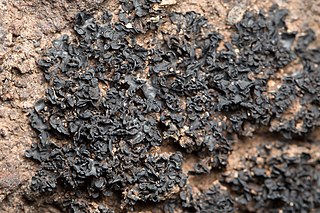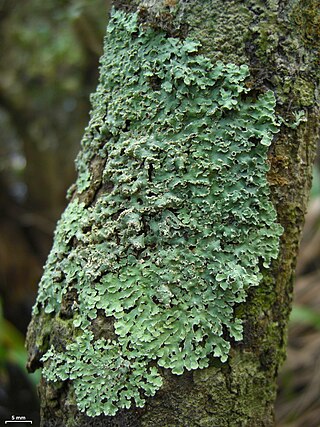
The Parmeliaceae is a large and diverse family of Lecanoromycetes. With over 2700 species in 71 genera, it is the largest family of lichen-forming fungi. The most speciose genera in the family are the well-known groups: Xanthoparmelia, Usnea, Parmotrema, and Hypotrachyna.
Inezia is a genus of South African plants in the sunflower family.

The Psoraceae are a family of lichenized fungi in the order Lecanorales. The Austrian Botanist and Lichenologist Alexander Zahlbruckner first described the family in 1898. Species of this family have a widespread distribution.

The Acarosporaceae are a family of fungi in the order Acarosporales. Members of this family have a widespread distribution, and are mostly lichenized with green algae. According to a 2021 estimate, the family contains 11 genera and about 260 species. The family is characterised by a hamathecium formed of paraphysoids.

The Lichinaceae are a family of ascomycete fungi. Most species are lichenized with cyanobacteria, and have a distribution largely in temperate regions.

Ramalina is a genus of greenish fruticose lichens that grow in the form of flattened, strap-like branches. Members of the genus are commonly called strap lichens or cartilage lichens. Apothecia are lecanorine.
Lithoglypha is a fungal genus in the family Acarosporaceae. It is monotypic, containing the single species Lithoglypha aggregata, a saxicolous (rock-dwelling), crustose lichen found in South Africa.

Thelotrema is a genus of lichen-forming fungi in the family Graphidaceae, the family to which all taxa in the former Thelotremataceae now belong.

Physcia is a genus of lichen-forming fungi in the family Physciaceae. The widely distributed genus contains about 80 species. The genus is cosmopolitan, and has been extensively studied in various regions in the past several decades, with significant biodiversity in South America identified as a central diversity hotspot. Physcia species are foliose, lobate lichens that grow with a loose to close appressed habit. Their upper surface is typically whitish, pale greenish, green-grey, or dark grey in colour. The thallus colour remains relatively unchanged when moistened. Physcia lichens typically grow on bark, on wood, or rock, although they have occasionally been recorded dwelling on man-made structures. They thrive in nutrient-rich environments and are expanding rapidly in urban areas of the United Kingdom previously affected by SO2 pollution.

Canoparmelia is a genus of lichen-forming fungi in the family Parmeliaceae. The widespread genus contains about 35 species. Canoparmelia, a segregate of the parmelioid lichen genus Pseudoparmelia, was circumscribed by John Elix and Mason Hale in 1986.

Punctelia is a genus of foliose lichens belonging to the large family Parmeliaceae. The genus, which contains about 50 species, was segregated from genus Parmelia in 1982. Characteristics that define Punctelia include the presence of hook-like to thread-like conidia, simple rhizines, and point-like pseudocyphellae. It is this last feature that is alluded to in the vernacular names speckled shield lichens or speckleback lichens.

Peltula is a genus of small dark brown to olive or dark gray squamulose lichens that can be saxicolous ) or terricolous. Members of the genus are commonly called rock-olive lichens. They are cyanolichens, with the cyanobacterium photobiont from the genus Anacystis. They are umbilicate with flat to erect squamule lobes that attach from a central holdfast or cluster of rhizenes. Lichen spot tests are usually negative.
Eremastrella is a genus of lichen in the family Psoraceae. The genus was circumscribed by the lichenologist Stefan Vogel in 1955, with Eremastrella tobleri assigned as the type species.
Glyphopeltis is a genus in the family Psoraceae. It is monotypic, consisting of the single saxicolous lichen species Glyphopeltis eburina, found in southern Africa. This species was formally described as a new species in 1985 by Franklin Brusse, who discovered the type specimen growing on the shaded lower surface of a dolerite boulder in Cape Province.

The Lecideaceae are a family of lichen-forming fungi in the order Lecideales. It contains about 30 genera and roughly 250 species. A major distinguishing characteristic of the family is the lecanoroid form of the fruiting bodies: typically circular, dark, and without a thalline margin. Most species in the family are lichenised with green algae, although a few species, scattered amongst several genera, are lichenicolous—they live on other lichens. Lecideaceae lichens tend to grow on rocks, wood, and soil. Several Lecideaceae species accelerate the weathering of rock surfaces, a process known as pedogenesis, by extending their hyphae into cracks and expelling rock flakes. This contributes to significantly faster weathering rates in certain environments, impacts various materials from natural rocks to man-made Sekishu roof tiles, and involves key biomolecules identified for survival and biodeterioration, including compounds to withstand intense ultraviolet radiation.
Coelopogon is a genus of lichen-forming fungi in the family Parmeliaceae. The genus contains two species found in southern South America and South Africa.
Coronoplectrum is a single-species genus of unknown familial placement in the order Lecanorales. The only species in the monotypic genus is Coronoplectrum namibicum, a fruticose (bushy), saxicolous (rock-dwelling) lichen found in Namibia. The genus was circumscribed by Franklin Brusse in 1987.
Psathyrophlyctis is a genus of lichenized fungi in family Phlyctidaceae. The genus is monotypic, containing the single species Psathyrophlyctis serpentaria, found in South Africa.










